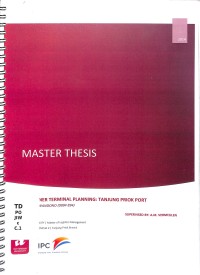Thesis And Disertation
Container terminal planning : tanjung priok port
Container handling activities in Tanjung Priok Port, the biggest port in Indonesia, received a lot of critics from customers. The port is perceived to be slow in executing its operation, which create unnecessary extra cost for customers. The port it self suffer from lack of backup area needed to expand its handling capacity. Expansion is necessary to anticipate the fast growing cargo traffic in the port. Without expansion, the port will be further congested which constraint port operation.
The purpose of this paper is to assist Tanjung Priok Port in improving container service productivity by recommending ideal container terminal layout that can be developed in the location within the port, using quantitative analysis to determine the required specifications of the container terminal.
The first chapter introduce the profile of PT Pelabuhan Indonesia II or IPC, the company that managed the activities in Tanjung Priok Port. This chapter also provides information regarding Tanjung Priok situation, and the problem it face, it also contains list of information required for decision making regarding container terminal.
Chapter two provides the theoretical framework that is used in analysis process. There are 2 main theoretical framework used. The main one is container terminal planning and management theory, which are used for determining the ideal design of container terminal. The second theory is regression analysis, mainly for forecasting purposes. Chapter three contains the explanation on how the research is conducted. The research method used is quantitive method, since there are a lot of quantifications used in the analysis to measure port performance and determining the specifications of the designed container terminal.
Chapter four outlines the data and information regarding the container handling service in Tanjung Priok Port, gathered during research. The information researched include the operations activities, the equipment and facilities, the performance. And the historical container data for the last ten years.
Chapter five consist of the analytical and problem solving process to determine the required container terminal specifications to improve the performance of the container service in the port. Chapter five also provides the container terminal design concept, based on the determined specifications.
Chapter six concludes the paper by giving recommendation on improving the container service performance. While chapter seven contains the writer's reflection about the paper.
Ketersediaan
Informasi Detail
- Judul Seri
-
Master Thesis
- No. Panggil
-
TD PO JIW c
- Penerbit
- Netherlands : Rotterdam University., 2014
- Deskripsi Fisik
-
77 p., ; 29 cm
- Bahasa
-
English
- ISBN/ISSN
-
-
- Klasifikasi
-
PO
- Tipe Isi
-
-
- Tipe Media
-
-
- Tipe Pembawa
-
-
- Edisi
-
-
- Subjek
- Info Detail Spesifik
-
-
- Pernyataan Tanggungjawab
-
Aryoko Jiwandono
Versi lain/terkait
Lampiran Berkas
Komentar
Anda harus masuk sebelum memberikan komentar

 Karya Umum
Karya Umum  Filsafat
Filsafat  Agama
Agama  Ilmu-ilmu Sosial
Ilmu-ilmu Sosial  Bahasa
Bahasa  Ilmu-ilmu Murni
Ilmu-ilmu Murni  Ilmu-ilmu Terapan
Ilmu-ilmu Terapan  Kesenian, Hiburan, dan Olahraga
Kesenian, Hiburan, dan Olahraga  Kesusastraan
Kesusastraan  Geografi dan Sejarah
Geografi dan Sejarah